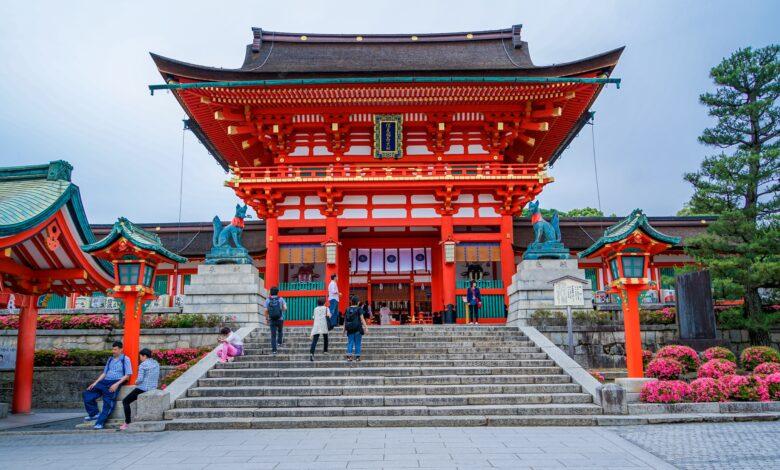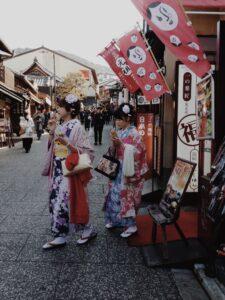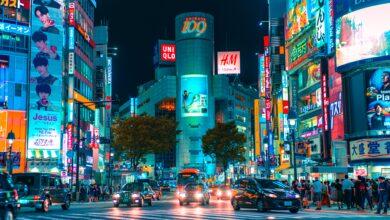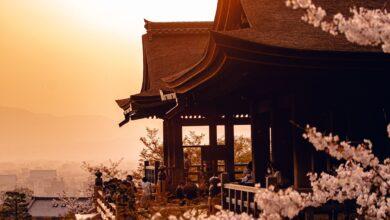🗺️ A Cultural Journey through Kyoto, Japan 🇯🇵
Immerse Yourself in the Rich Heritage and Traditions of Kyoto

Introduction
Step into a world where time stands still, and the spirit of ancient Japan resonates through every cobblestone street and tranquil garden. Kyoto, a city that has served as the cultural heart of Japan for centuries, offers a mesmerizing journey through time and tradition. In this blog post, we invite you to join us on a captivating cultural journey through Kyoto, Japan, where the past and present gracefully intermingle, creating an enchanting tapestry of experiences. From historic temples and the elegance of geisha culture to traditional arts, culinary delights, and seasonal wonders, Kyoto beckons travelers to immerse themselves in its rich heritage. So, grab your virtual kimono, and let’s embark on a cultural voyage like no other.
Exploring Kyoto’s Historic Temples and Shrines
Kinkaku-ji (The Golden Pavilion)
Kinkaku-ji, also known as the Golden Pavilion, is one of Kyoto’s most iconic and enchanting landmarks. This Zen Buddhist temple, covered in brilliant gold leaf, is a testament to the city’s rich cultural heritage and architectural beauty.
The history of Kinkaku-ji dates back to the 14th century when it was built as a retirement villa for a shogun. Later, it was converted into a temple, and it has been a source of inspiration for countless visitors ever since. The temple’s top two stories are adorned with gold leaf, while the third story features intricate architecture and a majestic phoenix figurine. The reflection of the pavilion in the tranquil pond that surrounds it creates a mesmerizing scene.
As you wander through the beautifully landscaped gardens, you’ll come across other historic structures, such as the Fudo Hall and the Sekkatei Teahouse. These offer a deeper understanding of Japanese culture and spiritual practices. Kinkaku-ji is a UNESCO World Heritage Site and is especially stunning during the changing seasons, with cherry blossoms in spring and fiery maple leaves in autumn.
Fushimi Inari Taisha and its thousand vermilion torii gates
Fushimi Inari Taisha is a sacred Shinto shrine and one of the most captivating and unique destinations in Kyoto. What sets it apart is the mesmerizing path lined with thousands of vermilion torii gates, creating a captivating tunnel of vibrant red hues.
The shrine is dedicated to Inari, the Shinto god of rice and prosperity, and each torii gate is donated by individuals or businesses seeking good fortune. The gates, called “torii,” create a mesmerizing journey up the slopes of Mount Inari, where Fushimi Inari Taisha is situated.
The hike through the torii gates is an enchanting experience, and the higher you ascend, the more breathtaking the views become. Along the way, you’ll discover smaller shrines, stone fox statues (guardians of the shrine), and serene spots for reflection. The summit offers panoramic views of Kyoto and the surrounding countryside, making it a rewarding destination for photographers and hikers alike.
Visiting Fushimi Inari Taisha is a blend of spirituality, nature, and culture, creating a unique and unforgettable Kyoto experience.
The serene beauty of Kiyomizu-dera
Kiyomizu-dera, or the “Pure Water Temple,” is another iconic treasure of Kyoto. This Buddhist temple is known for its vast wooden terrace that extends out from the main hall, offering awe-inspiring views of the city and the lush forested hills.
The temple’s main hall is a marvel of Japanese architecture, constructed entirely without the use of nails. Kiyomizu-dera is named after the Otawa Waterfall, which flows through the temple grounds, offering visitors the chance to drink from streams believed to bring good luck and fulfill wishes.
Kiyomizu-dera is especially renowned for the panoramic vistas it provides during the cherry blossom season in spring and the vivid foliage in autumn. The surrounding forest creates a serene ambiance that invites contemplation and appreciation of nature’s beauty.
The temple complex includes various shrines, halls, and Jishu Shrine, dedicated to love and matchmaking. Visitors often engage in the tradition of walking between two stones with their eyes closed to find true love. Kiyomizu-dera’s spiritual and natural beauty makes it a must-visit destination for those exploring the historic temples and shrines of Kyoto.
The Elegance of Geisha Culture
Introduction to geisha and maiko
Geisha culture is a captivating and time-honored tradition in Japan, known for its elegance, grace, and commitment to preserving the country’s rich cultural heritage. Geisha and their apprentice counterparts, known as maiko, are artists skilled in various traditional Japanese arts, such as music, dance, and the art of conversation.
Geisha, often referred to as “geiko” in Kyoto’s dialect, are professional entertainers trained in the geisha arts. Their role is to provide entertainment, conversation, and cultural performances for guests at teahouses, banquets, and traditional events. Maiko are young apprentices who undergo rigorous training to become fully-fledged geisha. They are recognized by their distinctive attire, including vibrant kimono, elaborate hairstyles, and exquisite accessories.
Both geisha and maiko are central figures in preserving Japan’s cultural heritage, and experiencing their world is like stepping into a bygone era of grace and artistry.
Experiencing a traditional tea ceremony
One of the most authentic ways to immerse yourself in geisha culture is by participating in a traditional tea ceremony, known as “chanoyu” or “chado.” The tea ceremony is a quintessential part of Japanese culture, emphasizing harmony, respect, purity, and tranquility.
During the ceremony, you’ll have the opportunity to witness the meticulous preparation of matcha, a finely ground green tea, and savor its unique flavors. The ritual itself involves precise movements, symbolic gestures, and the exchange of pleasantries, all guided by a knowledgeable tea master.
Geisha and maiko often partake in the tea ceremony, adding an extra layer of elegance and cultural significance to the experience. Their presence enhances the ambiance and provides a deeper understanding of the ceremony’s historical importance.
Tea ceremonies are conducted in traditional tea houses and cultural centers throughout Japan, with Kyoto being a prominent location for this immersive cultural experience. It’s a chance to savor the tranquil beauty of Japanese traditions and engage with the graceful world of geisha culture.
The Gion district: A glimpse into the world of geisha
For many, the Gion district in Kyoto is synonymous with the world of geisha. This historic neighborhood is renowned for its well-preserved machiya (traditional wooden townhouses) and cobblestone streets, providing a glimpse into the Japan of the past.
Gion is one of the few places in Japan where you may have the opportunity to encounter geisha and maiko in their traditional attire. The evening hours are especially ideal for spotting them as they move gracefully between appointments and tea houses.
The district is home to numerous teahouses and traditional ryokan inns, where geisha and maiko entertain guests with music, dance, and conversation. While it can be challenging to secure an invitation to a private function, there are some publicly accessible events, such as the Gion Odori, an annual dance performance, and the springtime Miyako Odori.
The Gion district also offers an array of quaint shops, cafes, and restaurants where you can immerse yourself in the enchanting ambiance of geisha culture. Don’t miss the opportunity to explore Hanamikoji Street, the heart of Gion, which is filled with beautifully preserved traditional architecture and a palpable sense of history.
Visiting Gion is a chance to step back in time and witness the elegance and grace of geisha culture, offering a truly unique and enchanting experience in the heart of Kyoto.

Traditional Arts and Craftsmanship
Ikebana: The art of Japanese flower arrangement
Ikebana, the traditional Japanese art of flower arrangement, is a captivating and highly regarded cultural practice. Rooted in centuries of tradition, ikebana is an exquisite blend of nature, aesthetics, and mindfulness. Each arrangement is a harmonious composition of line, balance, and harmony.
The art of ikebana values simplicity and emphasizes the inherent beauty of natural materials. Ikebana practitioners carefully select seasonal flowers, branches, and leaves, arranging them in a way that creates a serene and captivating design. This practice encourages a deep connection with nature, as well as a sense of meditation and mindfulness while crafting each arrangement.
Ikebana has various schools, each with its own unique techniques and philosophies. Visitors to Japan can partake in ikebana workshops or observe masterful arrangements at temples, cultural centers, and flower shows. Experiencing ikebana is a window into the soul of Japanese aesthetics and the reverence for the ephemeral beauty of the natural world.
Kyoto’s renowned textile industry and the art of kimono
Kyoto’s rich history and culture have made it a hub for traditional craftsmanship, and one of the most celebrated art forms is the creation of the kimono. The kimono, a symbol of Japan’s heritage, is a work of art in itself, reflecting the country’s deep appreciation for color, texture, and design.
The process of crafting a kimono is meticulous and labor-intensive. It involves dyeing, weaving, and embroidery, often performed by skilled artisans who have honed their craft for generations. Kimono patterns and designs carry profound cultural significance, showcasing themes like nature, seasons, and historical narratives.
Visitors to Kyoto can explore the city’s textile and kimono district, Nishijin, where they can witness the artistry behind these exquisite garments. Many shops and studios offer kimono rentals, allowing visitors to don these stunning garments and experience a taste of Japanese tradition.
Kimono-clad individuals can explore Kyoto’s historic streets, visit temples and shrines, or even participate in tea ceremonies. Wearing a kimono is not just a fashion statement but a deep connection to Japanese culture and the art of textile craftsmanship that has stood the test of time.
Noh and Kabuki theater performances
Japan’s traditional theater arts, Noh and Kabuki, are captivating and elaborate performances that have been cherished for centuries. Both art forms are renowned for their rich history, elaborate costumes, dramatic storytelling, and mesmerizing music.
Noh, the oldest of the two, is a classical form of musical drama characterized by its stylized masks, slow, deliberate movements, and the use of a chorus. Noh plays often convey profound, mythological stories and are performed by highly skilled actors who have undergone rigorous training.
Kabuki, on the other hand, is a more colorful and dynamic form of theater, featuring elaborate makeup, vibrant costumes, and exaggerated gestures. Kabuki’s tales encompass a wide range of genres, including historical dramas, tragedies, and comedies. Kabuki actors are celebrated for their versatility and dramatic prowess.
Visitors to Japan can attend Noh and Kabuki performances in theaters throughout the country, with Kyoto being a particularly significant hub for traditional arts. Watching a Noh or Kabuki performance is an immersive experience, as the actors transport audiences to another time and place through their storytelling and artistry.
Noh and Kabuki represent a profound connection to Japan’s cultural heritage, and witnessing these performances is an opportunity to engage with the country’s artistic soul and traditional craftsmanship.
Culinary Delights in Kyoto
Kaiseki Cuisine: A Multi-Course Culinary Experience
When you visit Kyoto, one culinary experience you simply can’t miss is indulging in Kaiseki cuisine. Kaiseki is an exquisite and traditional Japanese dining style that showcases the finest seasonal ingredients prepared with precision and skill. This multi-course meal is a true culinary delight, offering a sensory journey that represents the essence of Kyoto’s food culture.
Kaiseki meals are often served in beautifully designed restaurants or ryokans, offering an ambiance that complements the artistry of the dishes. The courses are meticulously arranged and served, with each element carefully selected to evoke the flavors of the season. You can expect an array of dishes, from sashimi and grilled items to simmered and steamed delicacies, all presented in an aesthetically pleasing manner.
Kyoto is renowned for its dedication to preserving tradition, and this is evident in the Kaiseki dining experience. Many Kaiseki chefs have trained for years to perfect their craft, making every bite a work of art. While Kaiseki can be on the pricier side, it is worth every yen for the opportunity to savor the purest flavors and immerse yourself in Japanese culture.
Exploring Nishiki Market for Street Food and Local Specialties
For a different but equally delightful culinary adventure, head to Nishiki Market in the heart of Kyoto. This bustling market is a food lover’s paradise, offering an array of street food and local specialties that will tantalize your taste buds.
As you stroll through Nishiki Market’s covered alleyways, you’ll encounter stalls selling everything from freshly grilled yakitori (skewered chicken) to mouthwatering takoyaki (octopus balls) and sizzling tempura. Don’t miss the chance to sample Kyoto’s renowned yudofu (tofu hot pot) and try local delicacies like tsukemono (pickled vegetables) and yuba (tofu skin). The market is also known for its fresh seafood and vibrant produce, which make for excellent ingredients to take home or enjoy on the spot.
Nishiki Market is not only about street food but also an opportunity to immerse yourself in the daily life of Kyoto and explore the unique ingredients used in the city’s traditional dishes. It’s a budget-friendly way to savor Kyoto’s culinary offerings while interacting with friendly local vendors.
The Art of Matcha Tea and Wagashi (Traditional Sweets)
Kyoto is steeped in tradition, and this is equally true for its tea culture. The city is renowned for producing some of the finest matcha tea in Japan, and you can’t visit without experiencing a traditional Japanese tea ceremony. The art of matcha is about more than just the tea; it’s a cultural and spiritual experience.
Participating in a tea ceremony allows you to witness the precision and grace with which matcha is prepared and served. The ceremony often includes a sweet treat known as wagashi, which is specially crafted to complement the bitter, earthy flavors of the tea. Wagashi, like matcha, is an art form in itself, and each piece is carefully designed to reflect the changing seasons and the spirit of hospitality.
Kyoto is dotted with tea houses and tea ceremony centers where you can partake in this centuries-old practice. The serenity and harmony of the tea ceremony provide a stark contrast to the bustling streets of Kyoto, making it a calming and enlightening experience for visitors.
Experiencing the Seasons in Kyoto
Cherry Blossoms in Spring and Hanami Tradition
Kyoto, Japan’s cultural jewel, is famous for its stunning cherry blossoms, and experiencing them in spring is a true treat for the senses. The arrival of cherry blossoms, or sakura, signals the beginning of spring in Kyoto, and the city transforms into a sea of delicate pink and white blooms.
The hanami tradition, which involves picnicking beneath the cherry blossoms, is a cherished practice among locals and tourists alike. It’s an opportunity to revel in the beauty of the blossoms and enjoy time with family and friends. Many parks and gardens in Kyoto, such as Maruyama Park and the Philosopher’s Path, offer ideal spots for hanami, with cherry trees in full bloom, creating picturesque settings for your festivities.
Don’t forget to try some sakura-themed treats during this season. You’ll find sakura-flavored ice cream, sakura mochi (sweet rice cakes), and even sakura-infused drinks. The atmosphere is filled with joy, and the sight of petals falling in the breeze is a symbol of life’s fleeting beauty.
Fall Foliage and Momijigari (Autumn Leaf Viewing)
Autumn in Kyoto is a time when nature paints the city with a breathtaking palette of warm colors. The crimson and golden hues of the fall foliage are an absolute spectacle, making it the perfect season for momijigari, or autumn leaf viewing.
Kyoto’s temples and gardens come alive with vibrant red and orange leaves. Some of the must-visit locations for momijigari include Tofuku-ji Temple, Arashiyama Bamboo Grove, and Kinkaku-ji (the Golden Pavilion). These sites offer stunning backdrops for your autumn exploration, and the cool, crisp air adds to the experience.
In addition to the natural beauty, the fall season in Kyoto offers a chance to savor seasonal cuisine. Be sure to try dishes featuring local specialties like chestnuts, sweet potatoes, and matsutake mushrooms. The fusion of delicious food and the incredible scenery is a sensory delight that will create lasting memories.
The Tranquil Winter Landscape of Kyoto
While spring and autumn draw the most attention, Kyoto’s charm continues through the winter months. The city takes on a tranquil and serene ambiance as the pace of life slows down. Winter in Kyoto offers a unique opportunity to explore the city with fewer crowds and a more intimate experience.
The temples and shrines, like Kinkaku-ji and Ginkaku-ji, are covered in a light dusting of snow, creating a serene and picturesque atmosphere. The stillness of the winter landscape, combined with the traditional architecture of Kyoto’s landmarks, makes for stunning photo opportunities.
Wandering through the historic streets of Gion or Higashiyama while wrapped in a warm winter kimono is a special experience. You can also savor hot pots and seasonal dishes in local restaurants, warming up with hearty Japanese comfort food.
In Kyoto, every season brings its own unique charm, and winter, with its peaceful allure, is an underrated gem for those seeking a more contemplative and less crowded visit to this captivating city.
Practical Tips for Your Cultural Journey
Best Times to Visit Kyoto
When planning your cultural journey to Kyoto, timing is key. Kyoto’s beauty and charm vary with the seasons, so selecting the right time to visit is crucial. Spring, from late March to early April, is the peak season to witness cherry blossoms (sakura) in full bloom. The city becomes a pastel wonderland during this time. Autumn, from late October to early December, is perfect for admiring the vibrant fall foliage. The moderate weather in both seasons is also ideal for exploration.
To avoid large crowds, consider visiting Kyoto during the shoulder seasons of late spring (May) or early autumn (September). The weather is still pleasant, and you’ll have a more peaceful experience at popular tourist spots.
Transportation and Accommodation Options
Getting to Kyoto is relatively easy, as the city is well-connected by train, bus, and even by air. If you’re arriving from Tokyo, the Shinkansen (bullet train) offers a swift and comfortable journey. Kyoto also has its own international airport, providing convenient access for travelers from abroad.
When it comes to accommodations, Kyoto offers a wide range of options. Traditional Japanese ryokans provide an authentic experience with tatami mats and futons. For those seeking modern comforts, there are numerous hotels, hostels, and guesthouses to choose from. Staying near Kyoto Station is a practical choice, as it provides easy access to transportation and a variety of dining options.
Don’t forget to plan your transportation within the city as well. Kyoto’s bus and subway system is efficient and covers most of the tourist destinations. Consider purchasing a Kyoto City Bus All-day Pass for unlimited travel within the city. If you plan to explore the outskirts, renting a bicycle is a fantastic way to enjoy the scenic beauty at your own pace.
Cultural Etiquette and Respectful Tourism
While exploring Kyoto’s rich culture, it’s essential to be aware of local customs and etiquette. When visiting temples and shrines, remember to bow slightly before entering, and do not point your feet towards the main altar. Speaking in hushed tones and refraining from loud laughter or disruptive behavior is considered respectful.
When you experience a tea ceremony or dine at a traditional restaurant, it’s customary to express your gratitude by saying “gochisosama deshita” at the end of the meal. Removing your shoes before entering a tatami mat room is also a common practice. Be mindful of these cultural norms to show respect to the local way of life.
Responsible tourism is crucial in preserving Kyoto’s heritage. Avoid littering, follow designated paths, and respect the privacy of residents. When taking photos, be mindful of signs indicating restricted areas. Kyoto is a place where tradition and modernity coexist harmoniously, and by being a responsible and respectful traveler, you contribute to the preservation of this unique cultural gem.
FAQs
Q. What is the best time to visit Santorini?
A. The best time to visit Santorini is during the spring (April to June) and fall (September to October) when the weather is pleasant, and the crowds are thinner.
Q.Do I need a visa to visit Santorini?
A. Greece is part of the Schengen Area, and most travelers from EU countries, the US, Canada, and Australia can enter without a visa for up to 90 days. Check the latest requirements before your trip.
Q. Are credit cards widely accepted in Santorini?
A. Yes, credit cards are widely accepted on the island. However, it’s a good idea to carry some cash for smaller purchases.
Q. What are some local dishes I should try in Santorini?
A. Don’t miss out on trying fresh seafood, Santorini’s famous cherry tomatoes, and the sweet dessert wine, Vinsanto.
Q. Is it safe to drink tap water in Santorini?
A. While the tap water in Santorini is generally safe to drink, most visitors prefer bottled water for its better taste.
Q. Are there any cultural customs I should be aware of in Santorini?
A. It’s a good practice to greet locals with a friendly “Yassas” (hello) and “Efharisto” (thank you) to show respect for the local culture.
Conclusion
As we bid farewell to Kyoto, we leave behind the echoes of temple bells and the graceful dance of geisha, knowing that we have witnessed something truly extraordinary. This ancient city, with its cultural treasures and timeless traditions, has a way of leaving an indelible mark on all who visit. We hope this cultural journey has ignited your passion for exploration, and that you’ll one day find yourself strolling along Kyoto’s historic streets, sipping matcha tea in a traditional tea house, or admiring the delicate beauty of cherry blossoms in spring. Kyoto, with its captivating blend of the old and the new, promises a cultural adventure like no other—a journey through time, a dance of tradition and modernity. We invite you to create your own chapters in Kyoto’s story, adding to the rich tapestry of this remarkable city’s cultural legacy. Until then, sayonara and may your own Kyoto journey be filled with wonder and discovery.
UP NEXT





Facebook Comments